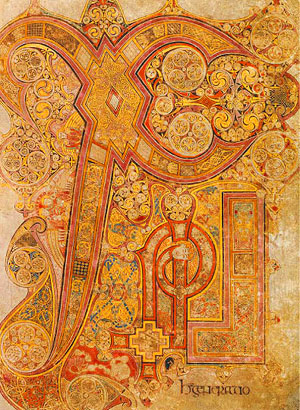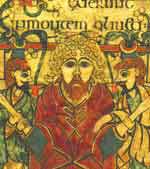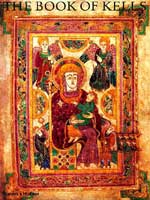| |

Traditions, folklore, history and more. If it's Irish, it's here. Or will be!
"People will not look forward to posterity who never look backward to their ancestors."
-Edmund Burke




Quotes
Library: Books, Movies, Music
Prints & Photos
Poetry
Jokes


Shops Ireland
Bunús na Gaeilge
(Basic Irish)
Circle of Prayer
Blessings
Did You Know?
Himself/Herself
Write to Us
Readers Write..
Links/Link to Us
Advertise with us
Awards & Testimonials
Submissions Guide


|
|
|
Emblems of Ireland:The Book of Kells
by Michael Carroll
 Almost as synonymous with the Emerald Isle as St. Patrick and the Shamrock, The Book of Kells is probably the most famous example of medieval illumination and calligraphy still in existence. Guest author, Michael Carroll, has uncovered some fascinating facts about this national treasure. For example, did you know that the book was written and decorated not by one hand, but several?
Almost as synonymous with the Emerald Isle as St. Patrick and the Shamrock, The Book of Kells is probably the most famous example of medieval illumination and calligraphy still in existence. Guest author, Michael Carroll, has uncovered some fascinating facts about this national treasure. For example, did you know that the book was written and decorated not by one hand, but several?
Scholars have detected the work of at least three different artists, who may or may not have been the calligraphers as well. Subtle variation in the lettering reveals something of the personality of each individual scribe. One seems to have preferred rounded letterforms written in a dignified hand, while another left evidence of his extroverted nature in his use of brilliant red ink and flamboyant pen flourishes.
 he Book of Kells, The Book of Durrow, The Lindisfarne Gospels and other Celtic manuscripts were written and decorated entirely by natural daylight. According to Marc Drogin in Medieval Calligraphy (Dover Books) the monasteries were so fearful of accidental fire that the use of candles or oil lamps was forbidden inside the scriptoriums (writing rooms) and libraries. The scribe worked from dawn till dusk, stopping only for prayer and meals or his turn at the hoe, working in the fields alongside his brethren. he Book of Kells, The Book of Durrow, The Lindisfarne Gospels and other Celtic manuscripts were written and decorated entirely by natural daylight. According to Marc Drogin in Medieval Calligraphy (Dover Books) the monasteries were so fearful of accidental fire that the use of candles or oil lamps was forbidden inside the scriptoriums (writing rooms) and libraries. The scribe worked from dawn till dusk, stopping only for prayer and meals or his turn at the hoe, working in the fields alongside his brethren.
The use of small red dots in Celtic manuscripts does not (contrary to some modern interpretations) represent the "universal life force", but was in fact a decorative device.
The technique, known to calligraphers as rubrication, was borrowed by the Celtic monks from Egyptian Coptic Christian manuscripts brought to Ireland by missionaries in the 5th century. The small red dots were used to outline large initials or to make a particular line of text stand out from the page. In later years, Celtic artists elevated the humble red dot into a high art form, creating complex webs of delicate knotwork and even animal interlace.
Before St. Patrick introduced books along with Christianity to Ireland, the Irish had no useful written language.

Ogham, a primitive system of slashes and dots, was used to inscribe names on gravesites and standing stones, but proved too cumbersome for everyday use. So, when the Roman alphabet was introduced in the fifth century, the Irish embraced it as their own, and even adapted it for the Gaelic tongue to record their ancient myths and legends.
 The production of a single copy of the Four Gospels such as The Book of Kells required that the monks keep a herd of as many as 1200 cattle, which also provided food and milk for the monastery. It has been estimated that The Book of Kells originally was written on the skins of about 185 animals. Paper being then unknown, this parchment was their only source of writing material.
The production of a single copy of the Four Gospels such as The Book of Kells required that the monks keep a herd of as many as 1200 cattle, which also provided food and milk for the monastery. It has been estimated that The Book of Kells originally was written on the skins of about 185 animals. Paper being then unknown, this parchment was their only source of writing material.
The monks who labored daily over their writing tables, endlessly copying out page after page of text, some of which they could barely translate, often grew fatigued and made errors. Just as modern calligraphers do, the scribes occasionally repeated a word or line, made a spelling mistake, and did not notice the error. In The Book of Kells there are numerous places where the red ink of the editor made later corrections to the Latin text. After a day's work was done, the young scribes often penned short notes, prayers or poems in tiny script in the margins. One later scribe finished copying out a text, describing it as: "...very long, very verbose, and very tedious for the scribe."

We are very grateful to Mr. Carroll for this contribution and we hope you will visit his beautiful web site. Celtic Design.
|
|
Fri, Sep 27, 2024
 The Galway Hooker The Galway Hooker
This unique vessel, with its distinctive curved lines and bright red sails, originated in the village of Claddagh. During the 19th century, hookers supported a significant fishing industry and also carried goods, livestock and fuel. Seán Rainey is remembered for building the last of the original boats, the Truelight, for Martin Oliver who was to become the last king of the Claddagh; as king, he was entitled to white sails on his boat. Since the mid seventies, many of the old sailing craft which were on the verge of extinction have been lovingly restored and new ones have been built. During the summer months they can be seen at festivals such a Cruinniú na mBád - the Gathering of the Boats - in Kinvara.
Click for More Culture Corner.
|
The Book of Kells

Over 100 color illustrations, dozens of enlargements, and commentary by the Keeper of Manuscripts at Trinity College make this book a bargain at twice the amazingly low price.
Click for the Book of Kells
Gold plated and richly enhanced with design elements from illuminations in Ireland's most treasured manuscript.
Click here for Kells Cross.
|
|
|




 The Galway Hooker
The Galway Hooker